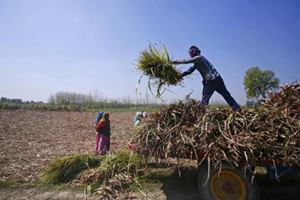One of Prime Minister Narendra Modi’s scheme managed to get more attention than other simply by the agenda for which it stood. Launched in August 2014, Jan Dhan Yojana aims at financial inclusion in the country by providing banking services to those who hadn’t enrolled for it till now. Run by Department of Financial Services, Ministry of Finance, on the inauguration day, 1.5 Crore (15 million) bank accounts were opened under this scheme and by June 206, over 22 crore bank accounts were opened and Rs 384.11 billion were deposited under it. However, a recent investigation by The Indian Express reveals, in what can be termed as a setback for this Yojana.
Few weeks after the scheme was launched, Kamlesh, a housewife at Purnapur village in Uttar Pradesh’s Bareilly opened an an account at the Punjab and Sind Bank’s local branch. being a wife a farmer, her opening balance was zero. Called as zero-balance accounts, half of the 17.90 crore Jan Dhan accounts comprised of these and the account holders were poor and had little or no savings.
But on August 5, 2016 when Kamlesh got her passbook updates, she was surprised to see that Re 1 had been deposited in her account on September 29, 2015.
“Re 1 had been deposited in my account on September 29, 2015. I didn’t deposit the money, I don’t know where it came from. I will ask the bank about this,” she said.
Investigating information obtained from more than 30 nationalised and regional rural banks under the Right to Information (RTI) Act, The Indian Express surveyed more than 25 villages and cities across six states in order to go deep into this.
It’s not just Kamlesh, and it’s not just that branch in Bareilly, or even that bank.
The result of the investigation resulted in a discovery. That is, bank officials were quietly making one-rupee deposits, many from their own allowances so as to reduce the branch’s tally of zero-balance accounts.
Since a large number of zero-balance accounts would have meant that people are not benefitting from the scheme, as many as 20 branch managers and officials told The Indian Express, on the condition that they not be identified, that there is “pressure” on them to show that zero-balance accounts are falling in number. So in order to show the effectiveness of the scheme, the “one-rupee” deposit was circled as a solution.
Indeed, as per RTI information provided, 18 public sector banks and their 16 regional rural subsidiaries held 1.05 crore Jan Dhan accounts with deposits of Re 1.
The RTI information obtained until August 2016 shows that the percentage of accounts with such deposits of one rupee is significant across banks and across the country. Take, for instance, the case of Punjab National Bank (see page 8), which has opened 1.36 crore Jan Dhan accounts of which 39.57 lakh (almost 29%) are those with deposits of Re 1. Bank of Baroda has 1.4 crore Jan Dhan accounts of which 12.97 lakh (9.26 per cent) have deposits of Re 1. There’s also UCO Bank with 74.6 lakh Jan Dhan accounts of which 11.06 lakh (14.83 per cent) have deposits of Re 1.
And those were just the top three. Punjab and Sind Bank, which currently has the least number of zero-balance accounts (0.40%), refused to provide details of Jan Dhan accounts with Re 1-Rs 10 in deposits.
At the macro level, the number of these zero-balance accounts has fallen sharply. From 76% in September 2014 to almost 46% in August 2015, then a steady fall to 24.35% on August 31, 2016.
After conversing with over 20 branch officials of various nationalised banks and their regional rural subsidiaries in Assam, Bihar, Chhatisgarh, Rajasthan, UP and Madhya Pradesh, The Indian Express found that that deposits of Re1- Rs 10 were sourced from various perks and other expenditure heads that come under their jurisdiction. These include entertainment allowance, conveyance allowance, canteen subsidy, office maintenance funds, and fee obtained for Demand Drafts and online transfers.
Many even admitted that they deposited these amounts from their own pockets, just to keep the accounts alive. For example, in Rajasthan’s Sawai Madhopur district, out of 40 bank passbooks scrutinised by The Indian Express, 15 had Re 1 credited by transfer as the first entry. None of the account-holders knew the source of these entries.
“In my branch, nearly 1,000 such accounts were opened. Due to pressure from the top level, I deposited Re 1 in many of those accounts myself,” said a branch official at Baroda UP Gramin Bank in Bareilly, a subsidiary of Bank of Baroda.
“I was heading another branch before being transferred here and I had personally put Re 1, Rs 2 and Rs 3 in around half of the around 1,000 accounts opened under Jan Dhan in that branch. It was the usual practice in the branch due to pressure from the top,” said an official of the Aryawarta Gramin Bank, a subsidiary of Bank of India, in Mainpuri, UP.
They said that these cash deposits were done manually with staff filling pay-in slips in bulk. In some cases, the money was transferred electronically by the banks’ Business Correspondent Agents (BCA) or Bank Mitras — contract staff who take banking facilities to rural clients — who are allowed to open accounts to deposit money they take from account holders under Jan Dhan before transferring them to individual accounts.
An official at Bank of Baroda’s Baler branch in Rajasthan claimed that the bank’s “business correspondents may have put Re 1 in those accounts to encourage banking practices” among villagers. “The branches have certain targets and there is pressure. For the last one year or so, we have ensured that new accounts are opened with some deposit. But there are issues with accounts opened earlier in bulk. It is difficult to persuade those account holders to deposit money,” said the official.


